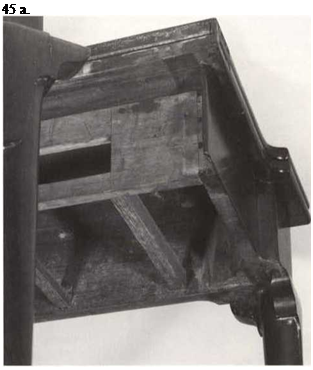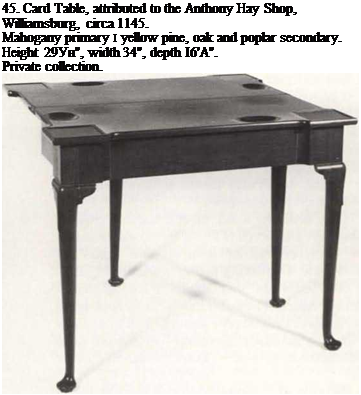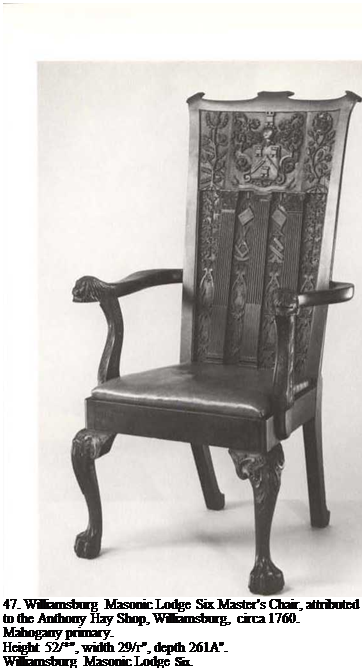Furniture Attributed to Hay
As w ith Peter Scott’s work, no signed or labeled furniture made by Hay is know n. Significant evidence concerning his shop’s production, however, is garnered from important pieces w ith Williamsburg histories, from archaeological excavation of the I lay shop site, and from the physical evidence presented by Bucktrout’s signed Masonic chair (fig. 49).
I laving noted the fairly homogenous nature of early W illiamsburg pieces and the extremely consolidated approach in the Scott group, it should be stated that products attributed to the 1 lay shop are far more varied in design and construction. This produces a much more complex picture to reconstruct, and a typological study is by necessity more fragmented, due largely to the steady stream of craftsmen that passed through the shop. These problems are overcome by very good documentation and by pieces with longstanding historical traditions.
The earliest pieces attributed to the I lay shop are tables, w hich are closely related to the latest examples from the early Williamsburg group. The separation of these pieces is, in fact, very difficult, particularly in the case of several early dining tables (see figs. 11, 12).
A marble-top side table made of cherry (fig. 43)
is the earliest piece firmly attributed to the Hay shop. I’he blue-gray marble top is the only example from W illiamsburg, but the trumpet-shaped section of its lower pad feet (similar to detail 57b) isseen on an unfinished easy chair leg that was excavated at the I lay site (fig. 65). In addition to the foot, the knee carving and flanking blocks of this table are virtually identical to those on two card tables (rigs. 44, 45) that are also related constructionally to a later example associated w ith Hay shop production (fig. 48). The undercut skirt detail (fig. 43b) is unusual and its execution is identical to a similar detail on a tea table in the early Williamsburg group (fig. 8). 1’his table descended in the Irby family and is thought to have first belonged to William Irby of Sussex (1752-1811) and to have been passed on to his son Edmund (1781-1829) of Nottoway. The table then went to Edmund’s son Richard (1825-1902), and from him to M iss Nellie Irby who gave it to her niece, Dorothy Fitzgerald, its present owner, in 1930.49
Two virtually identical card tables relate closely to the design of the preceding example (figs. 44, 45). Both exhibit excellent workmanship, are constructed of mahogany, and have shaped tops that correspond to their shaped skirts. These examples also have knee carving that associates them with the preceding side table, and they once had small drawers hidden in their skirts behind the swing leg, though they are now missing. Both tables have an unusual skirt construction in w hich the tops of the rear legs are neatly concealed behind the sides of the table. This causes an unusual sw ing-leg arrangement

in which the table’s side skirt overlaps the top of the gate leg when closed (fig. 45a). Another example of this type of leg construction is seen on a later table from this same group (tig. 48c). It should be noted that this arrangement is conceptually related to the applied skirt found on the early Williamsburg tea table (tig. 8), where the continuous skirt also hides the vertical leg joints.50 While these Virginia card tables are the only known examples of this construction made in America, they are clearly derived from English prototypes. Another feature, one that is common in England but equally rare here, is the interesting knee carving found on these three early I lay tables (figs. 43, 44, 45).
The first of these two card tables (fig. 44) descended in the Semple family. Its first known owner was Parson James Semple of St. Peter’s Church in New Kent County, who served as pastor there from 1767 until his death twenty years later. The table has remained in the family until the present day.51

 |
 |
The second card table (fig. 45) is one of a surviving pair w ith a historv of ownership on the Eastern Shore of Virginia. Its pad feet represent a slight variation of the trumpet shape discussed earlier. Like the preceding example, it appears to date from the 1740s, though a date as late as the 1750s is possible. This dating is based upon their relationship to the early Williamsburg group and the next phase of development in the I lay shop, which is considerably more advanced in style.
This new phase of production in the I lay shop reflects the rococo fashion that w as dominating taste in w estern society by the middle of the eighteenth century. Understandably, the earliest Hay shop examples in this style have rococo ornamentation applied to earlier George II forms. The premier Williamsburg example of this period, and also the earliest, is a magnificent ceremonial armchair made for the Capitol in Williamsburg (fig. 46). It w as taken to Richmond when the capital was moved there in 1780. It was eventually consigned to the attic, and early in the twentieth century was given to a custodian now known only as Mr. Dillard. It was sold by Dillard to Hugh Proctor Gresham, an antique dealer from Richmond who in turn sold it to J. F. Biggs, also of that city. In 1928, Dr. W. A. R. Goodwin purchased the chair from the Biggs Antique Company for Colonial Williamsburg.52 Appearing to date from the 1750s, this piece most likely served as the Governor’s chair in the General Court, and a set of similar chairs of regular height may have originally accompanied it. Its imposing stance and height would necessitate the use of a stool, and though the form may appear awkward to the twentieth-century eye, it was often used for elaborate ceremonial purposes two centuries ago. The throne of George III, similarly proportioned, survives today with the original footstool intact. The majestic effect that such a suite is intended to project is readily apparent in John Singleton Copley’s London portrait of Henry Laurens, colonial Governor of South Carolina (fig. 460- The elaborate canopy show n, undoubtedly representing the manner in which the Capitol chair was displayed, is further intended to reinforce the status and power of the individual seated in it.
Colonial Governors represented an extension of the King’s authority, and the lavish elegance of these chairs is certainly in accord w ith their royal connotation. They contrast w ith the austere formality of the Speaker’s chair of the Virginia House of Burgesses (fig. 7) and the British I louse of Commons, both bodies of elected legislators.53
The primary wood of the Capitol chair is mahogany, and beech is found in secondary usage. The front seat rail and two diagonal braces arc yellow pine. Displaying poorer workmanship than the other elements, they appear to be eighteenth – century repairs. The upholstery is new, although it now displays the correct contours, w ith brass tacks in the original holes. Several of the carved knee brackets arc also replaced, as are the tips of the rear feet.

 Because of the superb carving and the use of beech, this chair has had an Fnglish attribution since
Because of the superb carving and the use of beech, this chair has had an Fnglish attribution since

 its acquisition by Colonial Williamsburg in 1928. There is now sufficient evidence to disprove this attribution and to indicate that the piece was actually made in the May shop. 1’his evidence is interwoven in the chair’s carved details, as well as in the details found on three pieces that follow (figs. 47, 48, 49). Their study will proceed individually, emphasizing interrelated features.
its acquisition by Colonial Williamsburg in 1928. There is now sufficient evidence to disprove this attribution and to indicate that the piece was actually made in the May shop. 1’his evidence is interwoven in the chair’s carved details, as well as in the details found on three pieces that follow (figs. 47, 48, 49). Their study will proceed individually, emphasizing interrelated features.
The carving and sculptural quality of the Capitol chair is the finest of its time, and the anatomical qualities of its paw feet and lion’s heads have no contemporary parallel in America. The knee carving is an English formula that also occurs in Massachusetts and New York furniture (fig. 46c), although the execution in this piece has a delicacy and a flow ing quality superior to them. This delicate quality is consistent in the carving of all four legs, and the arm supports are equally well executed. Inside the arm supports is unusual geometric carving similar to that found on gilded English looking glasses. The elements include concave-sided diamonds, a cabochon, and a complex circle, all located within a chip-cut border (fig. 46c).
An impressive Masonic Master’s chair (fig. 47) shares interrelated features with the Capitol chair. Traditionally, it is said to have been given to Williamsburg’s Eodge Number Six by Lord Botetourt, Royal Governor of Virginia from 1768 to 1770. Its arm supports, carved in designs almost identical to those of the Capitol chair, are nearly square in cross section from the seat rails to the arms (fig. 46b, 47c). T he outside corner on each arm forms the central vein of the long acanthus, which begins as two scrolls flanking the bottom corner at the level of the seat rail. The effective curled tip of the acanthus, found on the Capitol chair arm supports (fig. 46b, 46c), has been omitted on the Masonic example, although the inside surfaces of the latter arm supports have the same geometric designs, in the same order, as those on the Capitol chair. Both have rounded bottoms on the lower sections of the arm supports where they join the seat rails. The acanthus carving of the arm supports is very good, although well below the highest order seen on the Capitol chair. There is also a noticeable decline in the curvature of the arm supports, but the greatest decline in quality and in understanding of design is evident in the carving of the lion’s head (figs. 46b, 46c, and 47c, 47d). Those on the Capitol chair display exceptional modeling, with subtle wrinkles and a complexity of shape, indicating that the carver not only had studied anatomy but also had understood it well. The lion on the Lodge Six chair shows a closely related anatomical approach, one that is particularly meaningful since English examples
exhibit enormous variation.54 It has lost both subtlety and complexity of shape, however, and a major departure can be seen in the modeling of the eyes and eye sockets. Those of the Capitol chairs are anatomically correct, with lids pointed down toward the nose in the front and, on the sides, toward the lower part of the ear. This essentially repeats the position of the eyes of an actual lion, although some stylization of the skull proportion has occurred. On the Masonic chair the eyes and eye sockets have been given a humanoid configuration. This loss of anatomical knowledge is even more dramatically evident in the mane carving.55
The well-formed cabriole legs of the Lodge Six chair are also related to those of the Capitol chair, with knee carving that is a variation of the asymmetrical design that is used on the Capitol chair. Again, the quality is not as high, although it is equal or superior to the variations of this design seen in New York and Massachusetts furniture. The smooth animal-paw foot, a London alternative to the hairy paw (fig. 47c), relate to those on the Capitol chair and represent the only known production of this type in eighteenth-century America. The back legs are similar to numerous examples illustrated in Chippendale’s Director, and the crest rail, with its volutes, is similar to those of the Scott group, although here the volutes are more attenuated.
 |
 The massive back of the Lodge Six chair, carved from a solid block of mahogany, undoubtedly serves as an intentional demonstration of the carver’s art. An easier method would have been to fashion it from separate pieces, which was a far more common technique for such construction. To better understand this laborious departure from tradition one must understand that eighteenth-century freemasonry emphasized craftsmanship, and in that respect the piece is a symbolic representation of the principles of their organization. (For a further understanding of this chair and its Masonic significance, see related material under “Ceremonial Chairs.”)
The massive back of the Lodge Six chair, carved from a solid block of mahogany, undoubtedly serves as an intentional demonstration of the carver’s art. An easier method would have been to fashion it from separate pieces, which was a far more common technique for such construction. To better understand this laborious departure from tradition one must understand that eighteenth-century freemasonry emphasized craftsmanship, and in that respect the piece is a symbolic representation of the principles of their organization. (For a further understanding of this chair and its Masonic significance, see related material under “Ceremonial Chairs.”)
|
|||||
|
|||||
|
|||||
|
|
|

|
A fine mahogany card table is closely related to these two ceremonial chairs (fig. 48). Its knee carving (fig. 48a), while much simplified, is a variation of the same formula, including the asymmetrical fronds and tilted C-scroll that point to the center of the table. The acanthus flows from the top volute of the tilted C-scroll on the card table and Capitol chair (fig. 46e), although the former docs not have the ruffled shell attached to the scroll like the Capitol and Ia>dge Six chairs. The simpler design may have resulted from economic considerations, but the naive quality reflects the carver’s lack of skill and understanding. Other aspects of this table relate to May shop production as well. The shape of the top, with its
recessed square and oval pockets, is identical to two earlier card tables in this group (figs. 44, 45), as is the hidden drawer and the continuous side skirts that overlap the swing-leg when closed (fig. 48c). The sinuous legs also have a quality and proportion similar to those of the early Williamsburg tea table (fig. 8) and a later side table (fig. 53).
This table is the most attractive surviving Virginia card table known to the writer. It is of extreme importance to the study of the Hay shop since it consolidates the early I lay production with the second phase represented by the Capitol and Masonic chairs.







